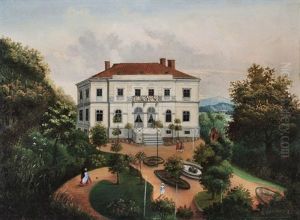Franz Wilhelm Leuteritz Paintings
Franz Wilhelm Leuteritz was a German artist born on April 24, 1817, in Dresden. He is primarily known for his work in porcelain design, being especially tied to the Meissen Porcelain Manufactory, where he served as the artistic director for several decades in the 19th century.
Leuteritz began his career at the Meissen factory in the 1830s as a painter. His talent and dedication allowed him to rise through the ranks, and he eventually became the head of the painting department in 1844. During his tenure, Leuteritz was instrumental in developing new techniques and designs, which significantly influenced the production of porcelain at Meissen and helped maintain the manufactory’s reputation for excellence in the face of increasing competition from other European producers.
One of his most significant contributions to the field was the development of the pâte-sur-pâte technique, a method of porcelain decoration where translucent layers of slip (liquid clay) are applied to create relief designs. This technique was highly prized for its delicate and detailed imagery and became a hallmark of Meissen porcelain.
As an artist, Leuteritz was influenced by various styles, including Rococo, Renaissance, and even Asian motifs, reflecting the eclectic tastes of the period. He was adept at adapting these influences into the medium of porcelain, creating pieces that were both innovative and respectful of Meissen's tradition.
Franz Wilhelm Leuteritz's influence extended beyond his technical contributions. He played a key role in the training and development of artists and craftsmen at the Meissen factory, ensuring the transmission of skills and nurturing the next generation of porcelain artists.
Leuteritz worked at Meissen until his retirement in 1883. His legacy continued through the many pieces he designed, which are still celebrated for their craftsmanship and artistry. He passed away on October 31, 1902, in Meissen, leaving behind a body of work that remains influential in the world of fine porcelain. Collectors and museums around the world continue to treasure his creations, and his impact on the porcelain industry is remembered as one of innovation and excellence.























